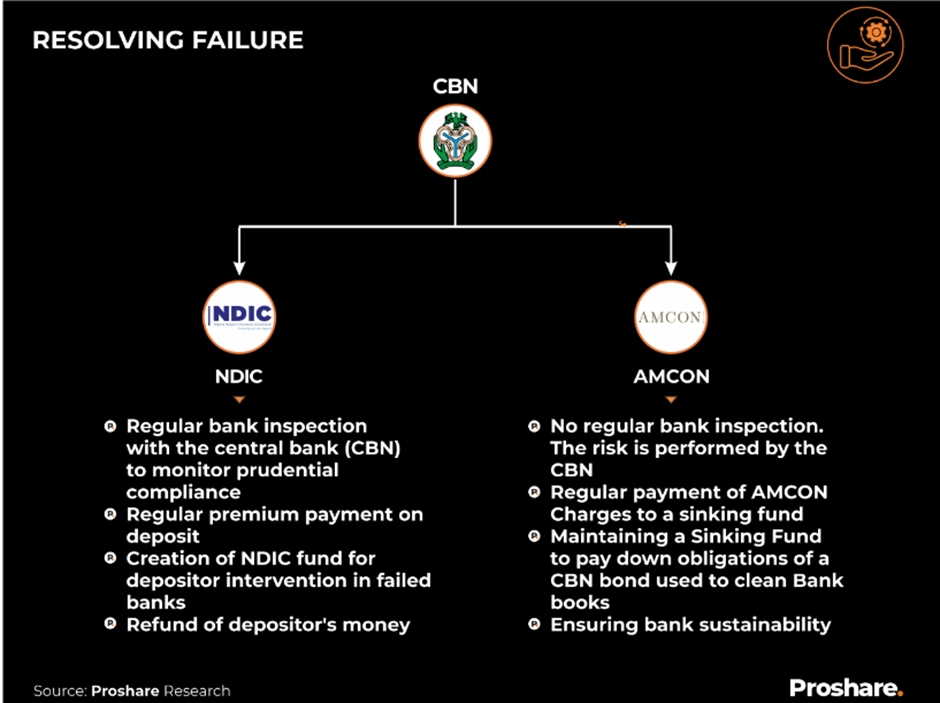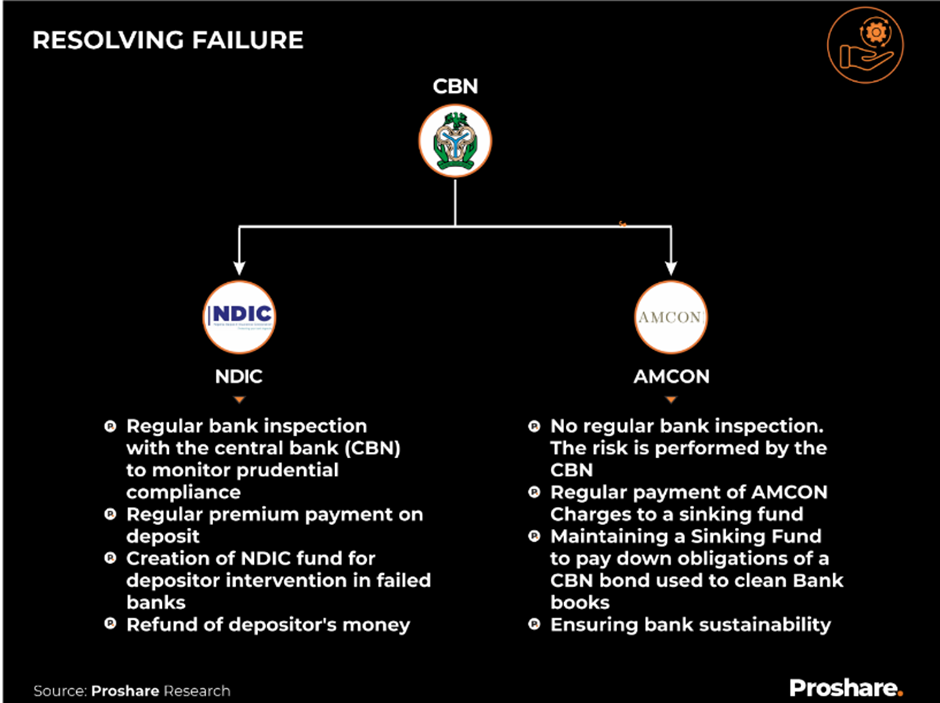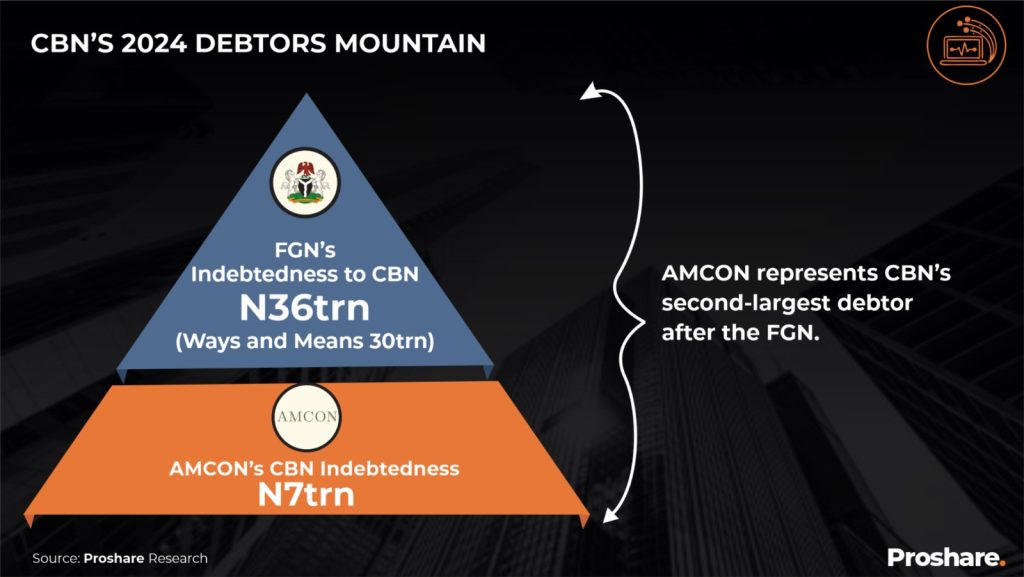
Setting the Context
The Asset Management Company of Nigeria (Amendment) Act, 2021, is like a lovely French souffle, crusty on the outside and soft in the middle. Its core mission was to be a key stabilizing and re-vitalizing tool in the Nigerian economy by ‘complementing the recapitalization of affected Nigerian banks; provide an opportunity for banks to sell off non-performing loans (NPLs), and free up valuable resources that enable banks to focus on their core activities’; it was never the intention to have it as a permanent institution.
Since AMCON’s establishment in 2010, Proshare has raised the point that asset resolution companies are not perpetual entities and are globally recognised to have finite lives. Against this background, Nigeria’s undertaker of toxic bank loans (AMCON) has run its full course and should be shut down. An undertaker/administrator should be engaged, or the Board should be mandated to address its over 600 staff members, over 10,000 lawsuits, hundreds of AMPs, and assets and liabilities or/and transfer same to the NDIC.

This case was made in our June 01, 2023 article titled Between AMCON and NDIC: Recalibrating Regulatory Roadmaps wherein we opined that “corporate strategists find it challenging to build a virtuous bridge between AMCON and NDIC. The two organizations appear united in vision but untethered in operations. While AMCON has grabbed the steering wheel of resolving banks’ toxic debt assets, the NDIC has laid hold on the transmission system of depositor protection. In theory, this does not raise a problem but creates a world of difficulties for bank cost management in practice. Walking the tightrope between bank depositor protection and toxic loan resolution has created a difficult regulatory oversight blindspot. While the NDIC is propped to cover depositors’ money in the event of a bank going bust, AMCON is charged with protecting the failure of a bank from becoming contagious.”
If we leave AMCON to run as if it where a standard operating entity, we run the risk of signalling that there is an ever-present problem within our financial system. Perhaps that is the message we stubbornly fail to grasp.

The AMCON Act, as amended, contrary to popular conception, did not stipulate a sunset clause as resolution practice demands. Truth be told, the ten-year period from our investigations, was an estimated final resolution time frame agreed between Khalifa Muhammed Sanusi II, the Central Bank of Nigeria (CBN) Governor at the time, and Mr. Mustapha Chike-Obi the AMCON’s inaugural chief executive officer (CEO). The agreement rested on calculations around the expected growth of banking assets over the decade between 2010 and 2020 and the domestic money centre banks’ (DMBs) capacity to support a sinking fund designed to retire the amount AMCON had spent to bail out the banking system. These assumptions did not pan out as expected, as we addressed on August 23, 2018.

Setting a timeline for winding up AMCON was necessary because its continued existence sends the wrong signal to the global financial market about a Nigerian banking system in perpetual distress. Asset resolution companies globally are designed to resolve problems, and once this is achieved, they fade into the horizon with warm memories of their triumphs. In the context of global best practices, AMCON, an asset resolution company, has reached its time to rest and retire. Why? With an estimated N7trn debt to the CBN, the bank debt resolution company is the second largest debtor to the money market regulator, after the CBN’s N36trn credit to the Federal Government of Nigeria’s (FGN) including the FGN’s Ways and Means (W&M) financing of roughly N30trn as of January 2024.

The AMCON Act clearly defined the institution’s mandate and the need to conclude its activities based on milestones and metrics. Unfortunately, we had such an opportunity which ended up being mired in legalese, rather than the practicality.
Nigeria’s Decision-Making Process and The MoF/CBN Divergence
An avoidable situation recently arose where a division, divergence, dichotomy, disagreement, or/and dissent between the Ministry of Finance (MoF) and the Central Bank of Nigeria honchos made sure a decision on its closure was side-stepped. Whereas the MoF decided to appoint an administrator for the AMCON to guide its winding up process, the CBN had other ideas and decided to appoint a new board of directors for the company. The Attorney General of the Federation (AGF) intermediated the division based on the interpretations of the powers of appointment. We contend that this was never about the powers of appointment but about a necessary fiscal side resolution to a monetary intervention.
While this was quickly swept under the carpet and announcements made, it still leaves concerns over the resolution of the fiscal debt, alignment of agency response by empowered agencies, institutional relevance, and governance consistency in decision-making. These concerns are captured in five key questions for which answers are not immediately available, viz:
- If the body is not to be wound up and the decision to appoint a new management is in accordance with the legalese, what are the arrangements to repay the CBN’s N7trn loan?
- Is the new board of directors a caretaker board to midwife the winding up of the body or one to continue running an agency for which its purpose has run its course, and its continued existence keeps us trapped in a ‘distress mode’?
- If the governments’ adoption of a realignment of multiple and overlapping agencies is to materialise, entities such as AMCON and NDIC co-existing signals an absence of faith in the banking industry’s governance around loans, for which far-reaching monetary decisions remain ongoing. It becomes pertinent to ask whether the CBN knows more than it lets on by retaining the current structure rather than setting up a new one. Should we, therefore, prepare for another NPL explosion?
- The revised NDIC Bill passed a second reading at the Nigerian Senate without considering the need to revise the deposit-protection institution’s scope of activities. If the NDIC Bill does not consider AMCON’s possible shutting down, and the adjustments necessary in the NDIC bill to take on the responsibility and lessons from AMCON’s intervention, are we not delivering an amendments bill that is not reflective of the progress made?
- Recalling that AMCON remains the longest-existing bank loan asset recovery agency in the world, how does this not send a strong signal that Nigeria does not expect that the banking system is out of its loan asset recovery cycle?
Noting that all asset resolution companies are terminal, how does Nigeria avoid having the longest-existing asset resolution body in global history with the consequent negative risk perception that delivers?
Let’s interrogate further what the decision taken meant.
While the CBN laws rightly vest the power of appointing members of AMCON’s board of directors in the financial market regulator, we note that given the special circumstance/situation where a decision must be taken on AMCON’s continued existence, the federal government had a unique opportunity to bridge the fiscal and monetary decisions apparent and necessary here in a manner consistent with its financial realities and the signalling required.
In choosing to maintain the status quo, the government did not present details on how it seeks to recover its N7trn from AMCON and how it avoids making a special purpose asset resolution vehicle into a permanent feature of Nigeria’s banking system architecture. As one observer puts it, “Plasters are meant for when an injury occurs, adorning a plaster over your left eyelid when the wound caused by bumping your head on the kitchen cabinet has healed or should have healed, is either a psychological romance with a fear of recovery, or a psychopathic covenant with the idea of pain. If AMCON takes over ten years to resolve the banking system’s bad loan troubles, then when in Heaven’s name will it settle the challenge of the system’s bad debt hole!”
According to the observer, ‘If a man says he wants to go mad for ten years, then after a decade of declaration insanity is yet to set in, has he already gone bonkers?!’ This is a difficult question to answer, but in the case of AMCON, the government must either wind up the company or tolerate the global questioning of Nigeria’s banking sector’s integrity, stability, and sustainability. The latter should be an outcome nobody favours.
Nigeria’s Asset Management Company (AMCON), a creation of regulatory convenience or inconvenience, depending on which side of the fence you sit on, needs clarification, lest the decision taken be considered a signalling of an impending need for a resolution vehicle on account of policy or policies taken.
A Peep at Role, Relevance and Retention Signals
AMCON, as conceived, became a lifesaving raft to protect depositors from losing their money. Through this vehicle, the Central Bank of Nigeria (CBN-supervised intervention agency) was able to help banks recover from the hubris and poor lending behaviour of their managers and directors. Protecting the banking system responsibly and sustainably was tricky as taxpayers’ money needed to be used in a way that did not reward the bad behaviours of bankers and their borrowers. In a report published by Proshare in 2020, the then former managing director of the AMCON, Mr. Mustapha Chike-Obi noted that ‘When we set out the initial framework for the policy, we said the sinking fund would be 30 basis points of the total assets of all banks operating in the financial market, but when Lamido Sanusi (the then CBN Governor) and I took a second look at this we thought that 30 basis points were too small. We then raised the basis points to 50, and the banks agreed. However, Sanusi feared that the amended figure was not in the statute books. So Sanusi said one of the fastest things he would want me to do is to get the laws speedily amended to adjust the basis points upwards.
AMCON was thus designed to leverage the ‘good bank vs. bad bank’ models in Europe to resolve banks’ loan delinquency problems. However, unlike the European models where the fragile institutions were split into two banks, the Nigerian version created the AMCON, designed to ‘manage’ the delinquent assets of the so-called ‘bad’ bank (or toxic loan depository). Further, unlike the European version, where the bad loans were warehoused in a separate bank, the Nigerian model made AMCON the universal buyer and manager of all the qualified bad loan assets of the banks.
Proshare analysts noted in the aforementioned report that ‘The CBN may need to revise its CRR rules and improve bank liquidity. Most importantly, banks’ cash balances with the CBN should NOT be subject to NDIC premium payments. Charging premiums on monies with the CBN presupposes risk associated with idle cash balances with the regulator. If this were the case, the CBN would be required to compensate banks for the riskiness of keeping cash with it because of the inflation-weighted cost of money, which means that CRR balances, both statutory and discretionary, should attract an interest rate. Unfortunately, banks have not been so lucky, and the CBN, in its wisdom, has not favoured interest payments on CRR. But that may not be a problem if banks did not have to pay insurance premiums on riskless cash balances.’
Staying Stuck in a Rut
Fifteen years after the resolution company was created, it is still stuck with N7trn in unrecovered bank loan assets, over 600 staffers, and 10,000 active court cases. If there was ever a time to roll up the stairways of an institution and take flight to clearer skies, it is now.
An increasingly popular school of thought agrees that AMCON may have outlived its usefulness. At a time when the Central Bank of Nigeria (CBN) is trying to establish transparency and credibility for its operations, they argue that the time is ripe for the regulator to figure out how best to unpack and resolve unrecovered toxic bank assets, reintegrate staff in permanent loan recovery institutions, and develop a practical framework for addressing its over 10,000 lawsuits.
According to a female officer of the organisation who requested anonymity, ‘The body needs to be reassessed, reimagined, and possibly reincarnated with a better governance framework, with less opaque institutional mandates. For example, why should AMCON be on the board of companies it should be preparing for sale? What is the organisation doing with Aerocontractors, and Arik Air?’
In addition, she asked, ‘Why did AMCON get embroiled in the messy acquisition of Polaris Bank, Union Bank and even Enterprise Bank in 2014?’. According to the ex-staff, ‘AMCON should be wound up under a guided governance arrangement, an outcome that does not seem likely with the fresh appointment of a new chief executive officer and directors. In a move that surprised a few industry watchers, rather than appoint a transition team to implement AMCON’s winding up, the CBN appointed a new set of board executives without providing the public with clarity on the board’s mandate and tenor.
Since the announcement, the dominant presumption in the marketplace is that the new board simply takes over from the old and continues managing troubled legacy loans, resolving knotty legal entanglements, and supervising collateral assets that are difficult to sell. In other words, the government’s fresh appointments represent the administration’s decision to tread water rather than head for a regulatory shoreline. Indeed, following the pattern of previous administrations, the lack of a clear policy mandate other than past objectives and targets buys the asset resolution authority some time before the inevitable.
The federal government and, and as we have seen, the CBN, must decide whether AMCON is a temporary loan asset resolution contraption or a long-term institutional oversight body for bad bank loans. Not resolving this issue raises a variety of issues centred around a possible breach of the Nigerian constitution enshrined in the amendment of the AMCON Act in 2019 after an earlier 2015 review.
Of CBN’s Recent MPC Measures and Banks’ Non-Performing Loan Assets (NPLs)
CBN, at its first monetary policy committee (MPC) meeting under the present administration, took decisively hawkish measures to rein in a freely rising domestic inflation rate (assuming they concluded that inflation was a demand-pull problem). Amongst the policy decisions, the CBN decided to:
- Increase the monetary policy rate (MPR) by 400 basis points from 18.75% at the end of 2023 to 22.75%.
- Widen the policy rates asymmetric corridor from
- Raise banks’ statutory cash reserve ratios (CRRs) from 32.5% as of 2023 to 45%.
- Leave the Banks’ statutory liquidity ratios at 30%
For most banks, the consequence of the CBN’s monetary policy would be a rise in domestic interest rates, an increase in the risk of domestic loan delinquency, and a rise in non-performing loan ratios (NPLRs).
In other words, AMCON may have to handle further hardcore loan delinquencies as banks see loan portfolios bludgeoned by rising interest costs. Noted one financial sector analyst: ‘The CBN’s extreme hawkishness could lead to a cyclone of unexpected or undesirable consequences. Manufacturers would likely see interest expenses rise as pass-through effects lead to an increase in commodity prices, a fall in the quantity of products demanded, and a rise in unsold stocks of goods. Therefore, manufacturers would likely either suffer a squeezing of profit margins or a fall in net sales, neither outcome leaving them looking pretty.’
‘If manufacturers serially collapse, then the balance sheets of banks will become shakier, and AMCON will have a real battle on its hands, one totally out of its control. Like a boat without a paddle, the asset resolution company may flounder.’
Some banking industry observers have requested that the AMCON Act be revisited to avoid this outcome. The institution should either be strengthened with a sunset clause or collapsed into the Nigerian Deposit Insurance Company (NDIC), which serves as a directorate responsible for delinquent loan recovery.
In addition, these leading industry actors have called for a revision of the NDIC premium charges and the AMCON levies, which are payments to the resolution company’s sinking fund used to repay the obligations of an earlier bond issue by the CBN to fund the injection of fresh money into banks in 2010/2011, at the height of a potential loan loss contagion. Evidently, we are not right-sizing policies with legal frameworks and market realities today (on account of CBN policies).
In a report by the Bank Directors Association of Nigeria (BDAN) in 2022, it was noted that banks suffer unduly under the burden of deductions by NDIC and AMCON. They called for a harmonization and downward review of the deductions. They noted that the NDIC premium deductions on bank deposits kept with the CBN through CRRs were inappropriate since the default risks of such deposits were nil. Unless of course, we are saying that deposits with CBN is risky.
According to the report titled ‘Between NDIC and AMCON: Recalibrating Regulatory Roadmaps’ the authors said, ‘Walking the tightrope between bank depositor protection and toxic loan resolution has created a difficult regulatory oversight blindspot. While the NDIC is propped to cover depositors’ money in the event of a bank going bust, AMCON is charged with protecting the failure of a bank from becoming contagious. Both institutions are strategically important, but the fixed annual charges associated with their oversight have added a financial burden on bank operations that needs urgent redress.’
Welcome to the Era of Systemically Important Companies (SIMCs)
While in the past AMCON and NDIC have focused on systemically important financial institutions like banks, the future may require a broadening of regulatory consideration around systemically important non-bank financial institutions or companies such as the Dangote Group, the BUA Group, Geregu, Seplat, MTN, Airtel, and the Transcorp Group amongst others. The notion of SIMCs creates an environment for wider regulatory consideration. Just as banks may be considered ‘too big to fail’, some non-bank institutions may now have earned, on account of government policies, the distinction of being placed in a similar category.
Assessing the credit risk profile of the top twenty percent (20%) of companies responsible for eighty percent (80%) of a bank’s credit risk portfolio may become an increasingly critical part of the regulatory surveillance process. Loan concentration measures and loan default stress tests will become major oversight components of companies considered too-big-to-fail, especially if listed on an official exchange like the NGX.
Who should be the regulatory body? The answer must be resolved, but the Securities and Exchange Commission (SEC) must play a key role for companies listed on the NGX or the NASD. Considering this, the SEC needs a technical makeover, one that unshackles itself from the underbelly of the CBN and fits the market’s future regulatory needs in contrast to yesterday’s oversight limitations.
AMCON: Purposefully Saying Goodbye to Yesterday
When the then CBN Governor, Khalifa Muhammed Sanusi II, decided to set up the AMCON with technically knowledgeable executives, the move was considered by industry players as a masterstroke in the stabilisation of the financial system. The industry had competent, albeit feisty gentlemen in charge of preventing a systemic meltdown of Nigeria’s banking system, the credibility to deliver confidence in the system, and the discipline to see it through.
The passion and vision of these professionals paid off as the potential challenges posed by a few fragile but relatively large banks were handled with skill, speed, and, more importantly, limited systemic disruption. The AMCON model was a case study in financial intervention delivered to global best standards.
However, almost a decade and a half after the initial AMCON safety-net was created, the justification for the continued existence of the institution has split the school of local financial analysts down the middle. While some have argued that AMCON needs to be in existence for what has been cryptically described as ‘the fire next time’ others insist that the loan resolution authority has outlived its usefulness and should be wound up in line with the original intention of the CBN at the time the body was created.
One observer with previous ties to AMCON who requested anonymity noted that ‘the AMCON was never designed as an evergreen institution but as an intervention mechanism with an understanding of a sunset time as a market signal to recovery from distress. The undocumented sunset tenor was then conceived as ten years, subject to the loan asset growth of the banks and their ability to fund the repayment of the CBN Bond used as a bailout facility. The adjustment that occurred was contingent on the bank’s asset size growth and repayment capacity. AMCON was expected to recover the amount invested in saving the banks from collapse. It was never seen as a philanthropist that kept on giving.’
The opposing school argue that AMCON was still needed in a situation where fragile economic realities could lead to some lending institutions buckling over, particularly those with negative shareholders’ funds and negative net open foreign exchange positions that have weakened their profit and loss accounts and damaged their retained earnings. A school member said, ‘You do not remove your umbrella because a rainstorm has become a heavy drizzle. You keep the umbrella up to prevent being drenched; the AMCON is a financial umbrella. It should be kept up and open.’
Closing Thoughts
Both schools have strong reasons supporting their positions, and this might have accounted for the middle of the road resolution of the divergence in positions taken by the Federal Government. However, the federal government must come out openly to clarify its position on AMCON. Appointing a new set of directors for the body fails to address AMCON’s continued purpose and the goals it should pursue. If AMCON must remain, a fundamental review of its laws must take place to redesign the body for a perpetual intervention role.; and in so doing, a revision of the mandate of the NDIC Bill which has passed a second reading at the Senate; and the perception risk of a perpetual loan default financial system.
In the absence of such change in the statutes, AMCON should be allowed to terminate its operations, which could be integrated into a reformed structure for the Nigerian Deposit Insurance Company (NDIC) while the bill is yet to be passed.
Whether AMCON should fade into the sunset or remain a permanent feature of Nigeria’s risk management architecture is a fiscal issue with monetary implications. It must be resolved, not swept under the threadbare carpet of political indifference.
The presidency must make a deliberate move concerning the fate of the loan resolution authority, AMCON. The longer it takes, the worse the legal issues of legitimacy will snowball into avoidable regulatory confusion, sub-optimal signalling, and incoherence in delivering a whole-of-government approach to financial system stability and governance




